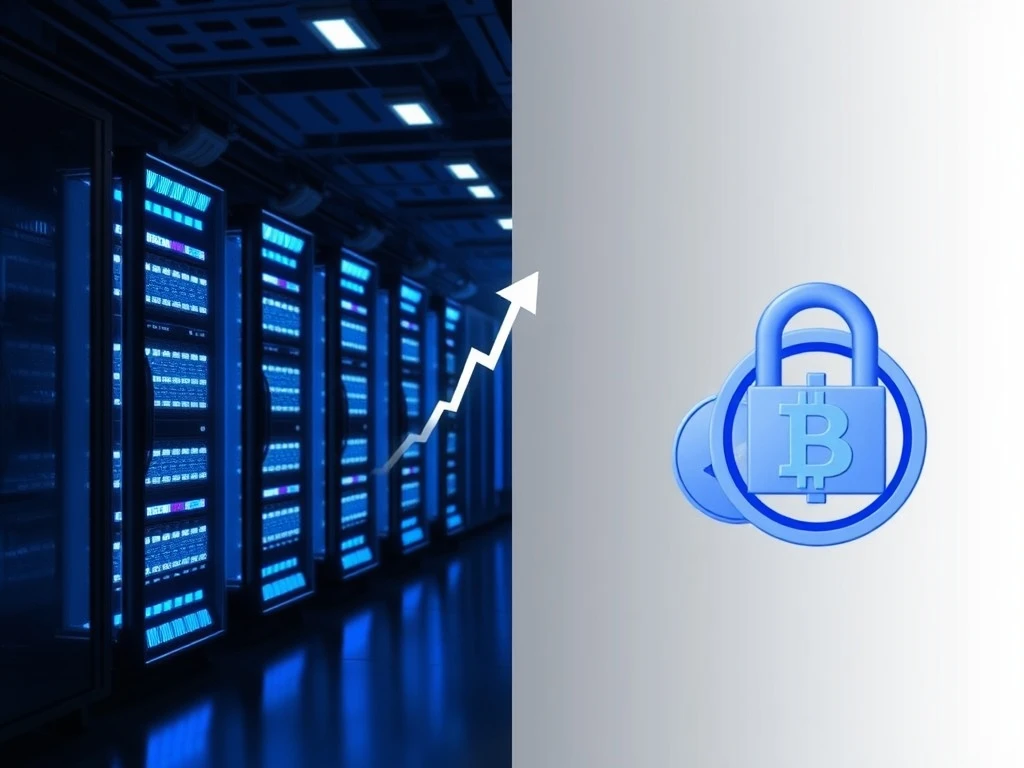Unlocking Crypto Earnings: Cloud Mining vs. Crypto Staking Profitability in 2025

Are you looking to maximize your crypto earnings 2025? The digital asset landscape offers diverse avenues for passive crypto income, with cloud mining and crypto staking standing out as popular choices. Deciding between them, however, requires understanding their unique mechanisms, potential returns, and inherent risks. This comprehensive guide breaks down the critical differences, helping you determine which strategy aligns best with your financial goals.
Cloud Mining vs. Crypto Staking: Fundamental Differences
Many investors consider both cloud mining and crypto staking for generating passive crypto income. However, these two methods represent distinct approaches to earning. Cloud mining involves renting remote hardware to mine cryptocurrencies like Bitcoin. Conversely, staking requires locking up your digital assets to support proof-of-stake (PoS) networks. This process helps validate transactions.
In 2025, reputable cloud mining platforms such as ECOS or MiningToken typically offer a return on investment (ROI) between 5% and 10% APR. Be cautious, however. Some high-risk schemes, particularly those linked to XRP, often promise unrealistic returns of 100% to 800% APR. These frequently resemble Ponzi schemes.
Crypto staking generally provides more consistent yields. For instance, Ethereum staking offers about 3% APY. Solana averages 6% to 8%. Liquid staking protocols, like Marinade, can even reach 10% to 12%. This article explores the staking vs mining debate for 2025. We compare various crypto income strategies, their real-world profitability, and the optimal balance of returns and risk for investors.
Understanding Cloud Mining Operations in 2025
Cloud mining provides access to Bitcoin or Ethereum mining without needing to own or manage expensive ASIC hardware. Users instead purchase contracts from large data centers. This effectively rents hash power, which mines cryptocurrencies on your behalf. You then receive daily rewards, after deducting service and maintenance fees. These payouts depend on the amount of BTC or ETH your rented allocation generates.
Several platforms lead the cloud mining market in 2025. These include MiningToken, ECOS, NiceHash, and IQ Mining:
- MiningToken highlights Swiss compliance, uses AI for hash allocation, and sources renewable energy. It offers flexible contracts, some as short as one day.
- ECOS operates from Armenia’s Free Economic Zone. It integrates mining with wallets and ROI calculators. Entry-level contracts start at just $50.
- NiceHash acts as an open marketplace for hash power. Users can buy or sell computing capacity with dynamic pricing. However, it applies approximately 3% in fees.
Typical Bitcoin cloud mining contracts deliver 5% to 10% APR. Yet, the industry also contains many speculative schemes. XRP-funded offerings, for example, often advertise 100% to 800% APR. These frequently operate as Ponzi setups. While advanced ASIC efficiency and renewable energy farms boost margins and sustainability, concerns about centralization and environmental impact persist. These factors are crucial when considering any staking vs mining scenario.
Did you know? Many Bitcoin mining farms in Iceland utilize natural Arctic air for cooling. This significantly reduces the need for costly air conditioning and lowers overall operational expenses.
Navigating Crypto Staking Strategies in 2025
By 2025, proof-of-stake (PoS) has emerged as a leading strategy for passive crypto income. Crypto staking enables token holders to “lock” their digital assets. This action supports a network’s security. In return, stakers earn rewards. While some users operate their own validator nodes, most delegate tokens to established validators. They then collect staking rewards, less a small commission fee.
Historically, staked tokens remained locked for days or weeks. However, liquid staking platforms like Lido and Marinade now issue derivative tokens (e.g., stETH, mSOL). These innovative tokens allow users to maintain liquidity while still earning yield. This flexibility enhances the appeal of crypto staking.
Crypto staking profitability varies across networks:
- Ethereum staking typically offers around 3% APY.
- Solana yields between 6% and 7%.
- Cardano delegators usually see 4% to 6%.
- Cosmos validators can achieve up to 18% (approximately 6% net via exchanges).
- NEAR protocol delivers 9% to 11%.
Compared to the often-volatile cloud mining earnings 2025, staking payouts are more stable. Risks still exist, including validator downtime, “slashing” penalties, and token price fluctuations. Nevertheless, the industry has matured considerably. Institutional investors now find regulated infrastructure, custody, audits, and insurance from staking-as-a-service providers. This makes PoS a credible option when evaluating staking vs mining scenarios.
Did you know? Smaller PoS networks, such as Injective, SEI, and SUI, provide double-digit staking yields. However, these often come with higher volatility and lower liquidity compared to major blockchains.
Profitability and Risk: Cloud Mining vs. Crypto Staking
Understanding the potential returns and risks is crucial when comparing cloud mining and crypto staking. The table below summarizes key differences for your crypto earnings 2025.
| Feature | Cloud Mining (Reputable) | Cloud Mining (High-Risk/XRP) | Crypto Staking (PoS) | Liquid Staking (PoS) |
|---|---|---|---|---|
| APR/APY | 5%–10% APR | 100%–800% APR (Unsustainable) | 3%–11% APY | Slightly lower than direct staking |
| Entry Level | Low | Low | Moderate | Moderate |
| Risks | Platform risk, limited liquidity | High scam risk, Ponzi schemes | Validator downtime, slashing, price volatility | Validator downtime, slashing, price volatility |
| Liquidity | Principal locked | Principal locked | Tokens locked (unbonding) | Tokens liquid (derivatives) |
| Profitability | Stable | Unrealistic | Steady | Flexible |
Passive Crypto Income in 2025: Investor Profiles
Your choice between cloud mining and crypto staking in 2025 largely depends on your investor profile.
1. Beginner and Low-Tech Users
Newcomers seeking passive crypto income with minimal setup often prefer cloud mining. Platforms like MiningToken or ECOS manage all hardware and node operations. They provide cloud mining earnings 2025 typically around 5% to 10% APR. However, exercise extreme caution. XRP-linked contracts promising 100% to 800% APR are frequently scams. Staking via exchanges or liquid staking services also offers a simple entry point. Ethereum staking yields about 3%, and Solana around 7%.
2. High-Risk, High-Yield Seekers
Aggressive investors might pursue speculative XRP cloud mining returns. Yet, these often lack transparency and pose significant risks. Safer, higher-yield alternatives exist within crypto staking. Delegating to Cosmos, Polkadot, or NEAR validators can generate 15% to 20% for those comfortable with more complex setups.
3. Institutional and Compliance-Focused Investors
Cloud mining generally lacks standardized audits and robust custody frameworks. In staking vs mining comparisons, staking has advanced significantly here. Providers now offer Know Your Transaction (KYT) and Know Your Business (KYB) checks. They also provide insured custody and regulator-friendly reporting.
4. Sustainability-Oriented Investors
Cloud mining relies on energy-intensive Bitcoin mining. In contrast, staking’s proof-of-stake model is far more eco-friendly. This makes it a clear choice for ESG-minded crypto investing. The environmental impact is a key differentiator in the staking vs mining debate.
Key Considerations for Your Crypto Earnings 2025
Beyond profitability, several other factors influence your decision between staking vs mining.
1. Tax Implications
Rewards from both crypto staking and cloud mining are generally taxed as ordinary income upon receipt. Subsequent sales may also trigger capital gains taxes. For example, in the UK, HMRC increasingly cross-checks exchange and cloud mining ROI data. This aims to identify under-reporting, and mistakes can lead to significant penalties. Always consult a tax professional.
2. Market Volatility
All payouts from passive crypto income strategies occur in cryptocurrency. Therefore, market swings can quickly erase fiat gains overnight. This risk is particularly pronounced in speculative XRP cloud mining setups. The value of your earned crypto can fluctuate significantly.
3. Liquidity
Cloud mining often provides daily payouts. However, your principal typically remains locked until the contract matures. Crypto staking can involve unbonding delays, where your tokens are inaccessible for a period. Liquid staking tokens offer a solution, allowing faster exits, though often with slightly reduced yields.
Did you know? On Cosmos-based chains, delegators can redelegate their tokens without undergoing unbonding periods. This enables switching validators without interrupting staking rewards, thus reducing downtime risk.
4. Platform Reliability
Always seek transparent, audited providers with clear Service Level Agreements (SLAs) and uptime data. Crypto staking platforms are increasingly publishing these metrics. Conversely, truly reliable cloud mining operations remain less common. Due diligence is essential.
Ultimately, choosing between staking vs mining for your crypto earnings 2025 depends on your personal investment goals. Your risk tolerance, sustainability priorities, and trust in providers will significantly shape how you decide to earn crypto in the coming year.








